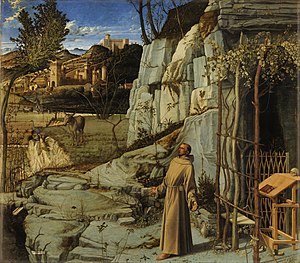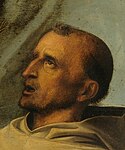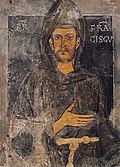User:Berrypuinitan/sandbox/St. Francis in Ecstasy (Bellini)
| St. Francis in Ecstasy | |
|---|---|
 | |
| Artist | Giovanni Bellini |
| Year | c. 1480 |
| Medium | Oil on panel |
| Dimensions | 124.6 cm × 142 cm (49.1 in × 56 in) |
| Location | Frick Collection, New York |
The Ecstasy of St. Francis (or St. Francis in the Desert) is a painting by Italian Renaissance master Giovanni Bellini, started in 1475 and completed around 1480. Bellini depicted the religious figure of St. Francis of Assisi in the landscape.[1] In 1852, the painting was listed on June 19th at Christie's.This painting was part of the 1857 Manchester Art Treasures exhibition. Currently, the painting now located at Frick collection, New York City.
Subject
[edit]The painting portrays the Italian 12th-century saint Francis of Assisi in an Italian landscape, stepping out in the sun from his cave, his figure anchoring the creamy celadon and golden-green landscape. The oil painting of Bellini has a length of approximately four feet with a width of around four and a half feet, depicting a natural, but dramatic scene. This painting includes one of the largest and most extensive Renaissance landscapes.[2]
Description
[edit]The painting contains a strong effect of mystical light through the use of golden rays coming from the uppermost left corner of the painting, showering over Saint Francis. The tones of brown and gold are used to illustrate the body, and a rocky niche is depicted in the shady portion. His brighter body contrasts with the darker environment of the painting. In the foreground, the focus is laid on stony, dangerous, dark and mossy cave with a shady entrance covered by twisted grapevines. Inside the cave, several possessions of the saint are represented such as Holy Book, desk, hermit’s skull, a thorny crown and a crucifix made of stems. Although the scene is rocky, it does not look like infertile.[3] In the center and the background of this painting, there is a walled hill with growing fields, a bridge over a running waterway, a coastal bird similar to a gray heron, a donkey, as well as a shepherd looking at his flock grazing. The landscape depicts a transformation into spring through the inclusion of growing grass.[3]
In the painting, the sky is dynamic, sparkling and bright blue. From the uppermost left edge, the light is falling, making its way inside the scenery. There is an illuminated feel arising from the whole painting, and a sense of rays originating from stones and green fields, making it feel like light has been stuck and the world itself is being illuminated through the holiness of St. Francs. The painting depicts St. Francis having came out of his cave fully covered in a brown traditional robe, standing barefooted, looking upwards at paradise with widely opened arms and heaving chest. The rocks around him in the painting are converting into stream, impaling his life has just transformed. In the painting, a mystical light is showered over St. Francis; he seems to be absorbing this light and spreading it throughout the entire painting. [3]
Materials
[edit]In Saint Francis in Ecstasy, Bellini used a combination of oil and tempera paints, perhaps having been under the influence of Antonello da Messina.The painting shows the influence of Andrea Mantegna, who was the painter's brother-in-law. It is signed IOANNES BELLINVS on a small, creased tag visible in the lower-left corner.[4] The original size of the painting was cut-down from the top side; this is evident because the painting continues completely to the end of the panel. However, the original painting would not be much larger than the present by estimation.[5] Saint Francis in Ecstasy was directed towards Art Museum Metropolitan for detailed cleaning and highly technical assessment of this painting by Scientists, Art Masters and Conservators, the painting had evidence of underdrawings.[3] The major findings such as compositional modifications, fingerprints, brushwork, sketching and the exposure of certain innovation belongs to the students of Bellini, i.e. Titian and Giorgione.[3]Though it has been cut down, it has otherwise been well-cared for since its creation.[5]
Symbolism
[edit]Bellini became sophisticated in his painting skill in the fifteenth century, the culmination of which is the Saint Francis In Ecstasy. The moment being depicted in the painting is Saint Francis’s stigmatization on the mountain of La Verna. Bellini envisioned the stigmatization as a moment of human transformation into the divine.[6] The sun’s rays shine on St. Francis, symbolizing him as a Seraph-Crucifix in front of the sun, which indicates the suffering image of the Seraphim.[2]
Francis lived under poor conditions during his later life and ministry and participated in isolated spiritual retreats at monasteries, as the painting shows; however, this painting is likely a symbolic representation of the saint. The animals in the picture may represent the saint's love for nature and animals.[7] The Ecstasy of St. Francis is depicting Francis in a religious ecstasy, perhaps receiving the stigmata, as Millard Meiss suggested though, when Francis is receiving the stigmata, usually an angel, a seraph or a crucifix emitting rays is depicted as well. Alternatively, he may be praying or perhaps singing his Canticle of the Sun, as Richard Turner has argued.[8]
Whatever the specific moment portrayed may be, the representation is a fresh one and does not follow any of the established iconographic motifs.[7]

In the left middle-ground is a donkey which can be interpreted as a symbol of humility and patience. In the lower right corner on a rustic reading table is a skull, representing mortality, welcomed in the last stanza of the saint's Canticle. The cave may relate Francis to Saint Jerome, who also lived in a cave or cell. The stream in the left middle-ground symbolizes Moses and the great spring, while the barren tree in the center of the painting represents the Burning Bush. The saint has left his wooden pattens behind and stands barefoot like Moses.[9]
On the green banks, there are a few bindweeds that opens at the dawn of light and fades away at day's end. The small garden contains various types of medicinal plants such as orris and mullein or Jacob's staff, and juniper. One of two fig trees lays on the right hand side of Saint Francis as leaves began to sprout from the remaining branch of the tree. The second fig tree lays on the cliff which surrounds itself with fruit. Each tiny flowers represents St. Francis as he embraced poverty, prayer and humility. The painting not only represent the “stigmatization”, but also the song that Canticle of the Sun composed by Saint Francis of Assissi. Canticle of the Sun is a religious song that appreciates god's creation of nature.[8] The overall message displayed shows Bellini's praises towards the kingdom of God's creation.[4]
- Details
-
Head of St Francis
-
Donkey
-
Stigmata, Right Hand
-
Hare
Landscape
[edit]In the distance rises the still-empty Heavenly Jerusalem. The overall composition is thought to be a meditation of St. Francis on the creation of the world as related in the Book of Genesis. In the distance rises the still-empty Heavenly Jerusalem.[8]Francis took refuge in Mount La Verna, a deserted place in the Apennines, outside of Areezo, Tuscany.[1]
Provenance
[edit]Zuan Michiel commissioned Bellini to create St. Francis in the 1480s. Taddeo Contarini acquired Bellini's St Francis painting after Zuan Michiel's death.[10] In 1660, St Francis by Bellini appeared in Marco Boschini’s dialect poem, when Boschini saw St Francis inside Giulio Guistiniani’s palace.[10] At the end of the eighteenth century, the picture still remained in the Cormaro Palace, according to Abbate Lanzi. The Frick St Francis might have left Venice for the first time at some point between 1796 and 1852.[10] This painting was offered for sale at Christie’s on 19th Jun 1852 and claimed to originally made for “a convent in the Milanese."[10]
In 1915, The painting published in the Frick Collection in New York City[11], displayed prominently in what was the living room of Henry Clay Frick, an American industrialist, financier, and art patron.[5] In 1915, Henry acquired the painting even though he had little interest in religious paintings. Frick valued this painting due to its includes of an extensive landscape. The painting is now in the Frick Collection and it is considered to be one of its finest assets.[5] The painting is in excellent condition.[5] The painting was included in the 1857 Manchester Art Treasures exhibition.[12]
External Media
[edit]| External videos | |
|---|---|
 | |
Sources
[edit]- ^ a b The Frick Collection. "Cocktails with a Curator: Bellini's "St. Francis in the Desert"".
{{cite web}}: CS1 maint: url-status (link) - ^ a b Tempestini, Anchise (1999). Giovanni Bellini. Abbeville press. pp. p.112. ISBN 9780789204332.
{{cite book}}:|pages=has extra text (help) - ^ a b c d e Esplund, Lance (2011). "A Shared Moment of Transformation". The Wall Street Journal.
- ^ a b The Frick Collection (2011). "Giovanni Bellini's "St. Francis in the Desert" FLORA (silent)".
{{cite web}}: CS1 maint: url-status (link) - ^ a b c d e The Frick Collection (2010). "Colin B. Bailey on Giovanni Bellini's St. Francis in the Desert".
{{cite web}}: CS1 maint: url-status (link) - ^ Kleiner, Fred S. (2010). Gardner's art through the ages. Book C, Renaissance and Baroque : the western perspective. Gardner, Helen, 1878-1946. (13th ed., Backpack ed ed.). Boston, Mass.: Wadsworth Cengage Learning. ISBN 0-495-79456-2. OCLC 318536109.
{{cite book}}:|edition=has extra text (help) - ^ a b "culturalinstitute/asset-viewer/st-francis-in-the-desert". www.google.com. Retrieved February 12, 2015.
- ^ a b c A similar suggestion is made by Anthony F. Janson, "The meaning of the landscape in Bellini's St. Francis in Ecstasy", Artibus et Historiae (1994:40ff); he suggests that the landscape is redolent of the Heavenly Jerusalem.
- ^ Horst Woldemar Janson, Anthony F. Janson, History of art: the Western tradition "Giovanni Bellini".
- ^ a b c d J.M, Fletcher (1972). "The Provenance of Bellini's Frick 'St Francis". The Burlington Magazine,. 114: 206–215 – via JSTOR.
{{cite journal}}: CS1 maint: extra punctuation (link) - ^ Marilyn Aronberg, Lavin; Liu, Jinyu; Gitner, Adam (2007). "The Joy of St. Francis: Bellini's Panel in the Frick Collection". jstor: 231–232.
- ^ Hamilton, James (2015). A Strange Business. New York, NY: Pegasus Books. p. 325. ISBN 978-1-60598-870-2.
- ^ "The Frick Collection's Colin Bailey on Giovanni Bellini's St. Francis in the Desert". Frick Collection. 2010. Retrieved February 20, 2013.
- ^ "Bellini's St. Francis". Smarthistory at Khan Academy. Retrieved February 20, 2013.
External links
[edit]Further reading
[edit]- De Vecchi, Pierluigi; Elda Cerchiari (1999). I tempi dell'arte. Vol. 2. Milan: Bompiani. ISBN 88-451-7212-0.
Category:Paintings by Giovanni Bellini
Category:1480s paintings
Category:Paintings of the Frick Collection
Category:Paintings of Francis of Assisi
Category:Birds in art
Category:Books in art
Category:Mammals in art





